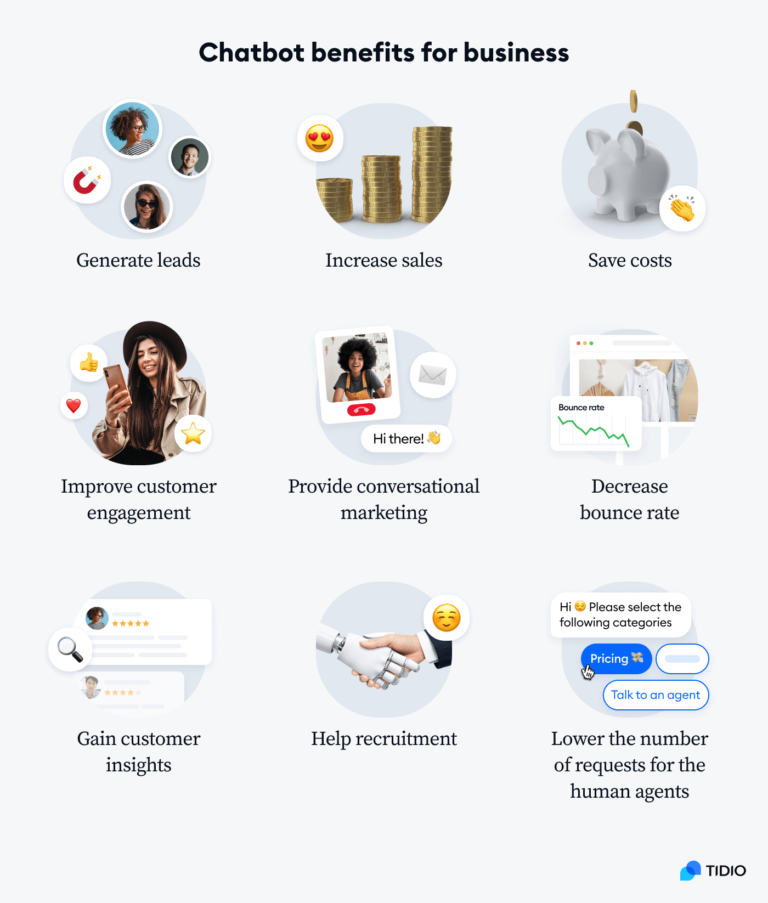How AI-powered chatbots can integrate into your website.
Contents
Small business owners are interested in learning more about AI-powered chatbots and how they can benefit their business. But, where do you start when it all seems so complex? The topic is overwhelming! This guide has been created to help you understand how chatbots can integrate with your website and the benefits they bring.
What is a chatbot?
Let’s start with the basics. A chatbot is a computer program that uses artificial intelligence (AI) to simulate human conversation. It’s like a virtual assistant that can help your customers find answers to their questions. They can be integrated into your website, social media, or even messaging platforms like Messenger or WhatsApp.
Five chatbot integrations for your website
Now, let’s dive into the five ways you can integrate AI-powered chatbots into your website:
1. Customer support chatbots
One of the most common uses of chatbots is customer support. You can program it to answer frequently asked questions, help customers track orders, or provide assistance with returns or exchanges. This reduces time and workload for your customer support team.
2. Sales and marketing
Chatbots can be used for sales and marketing purposes. You can program it to recommend products or services, offer discounts or promotions, or help customers make purchases directly through the chat window. This can be a great way to increase sales and improve customer engagement.
3. Personalised recommendations
AI-powered chatbots analyse customer data and provide personalised recommendations to customers based on their browsing history and purchase behavior. This can help your customers find products that are relevant to their interests and increase the chances of making a sale.
4. Booking and scheduling with chatbots
Chatbots can book and schedul appointments or reservations. For example, a salon could use a chatbot to book appointments, send reminders and accept payments. This can save time for both the business and the customer.
5. Data collection
Chatbots collect data about customer interactions, which can be used to improve your business operations. Analyse your customer feedback, identify common issues, and make improvements to your products or services based on the data.
Benefits of chatbots for small business
Now, what are the benefits of using chatbots for your small business? Here are some of the advantages:
- Cost-effective: They’re a cost-effective way to provide 24/7 customer support without the need for a large team of customer support agents.
- Increased efficiency: They can handle routine tasks, freeing up your team’s time to focus on more complex issues.
- Improved customer experience: Chatbots provide quick answers to customer questions, reducing wait times and improving customer satisfaction.
- Customer interaction analysis: They collect valuable data about customer interactions, which can be used to improve your business operations.
- Specialised customer engagement: By analysing customer data, chatbots can offer tailored recommendations, special offers, and loyalty programs that are more likely to resonate with customers. This can lead to increased customer loyalty and retention.

Get started integrating your chabot
AI-powered chatbots help small businesses improve their customer support, increase efficiency, and drive sales and revenue. You can provide a better customer experience, improve customer engagement and gain a competitive advantage by integrating chatbots into your website. Here are some tips to get started if you’re interested in implementing chatbots for your small business:
- Define your goals: Determine what you want to achieve with your chatbot. Do you want to provide customer support, increase sales, or improve customer engagement?
- Choose a platform: There are many chatbot platforms available, such as Dialogflow, BotStar, Chatbase and ManyChat. Choose a platform that fits your needs and budget.
- Develop a chatbot strategy: Determine the personality and tone of your chatbot, and create a conversation flow that aligns with your business goals.
- Train your chatbot: Use machine learning algorithms to train your chatbot with customer data and interactions. This will help your chatbot become more accurate and effective over time.
- Test and refine: Test your chatbot with a small group of customers and refine its performance based on feedback and data analysis.
You can create an effective chatbot that helps your small business grow and succeed by following these tips.